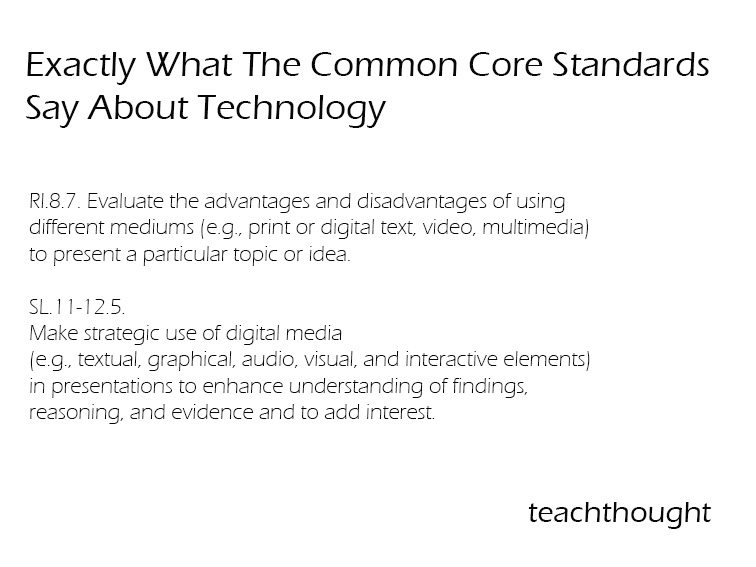 Exactly What The Common Core Standards Say About Technology
Exactly What The Common Core Standards Say About Technology
by TeachThought Staff
The Common Core Standards, the national academic standards that states are using to establish a common national index of academic content in the United States, have now been adopted by 47 of the 50 states in the U.S. This makes them the pre-eminent source of what is being taught in the vast majority of public schools in America.
Much has been made in the blogosphere and across social media of the changes compared to former academic standards that were dictated at a state level. Reactions usually involve the added demand these standards place on text complexity and general rigor. Since they’re only available for English-Language Arts and Math, it’s difficult to get a full picture for how they will impact public education, but some inferences can be made based on the sampling of ELA standards.
Four standards from elementary, middle, and high school English-Language Arts appear below, and we’ve got some takeaways below that. to help take a closer look at exactly what the “standards” say about technology.
Common Core Standards
Note: The first letter represents the strand (or “area”—reading, writing, etc.), the following number the grade level, and the last number the standard number. Bold text added for emphasis.
W= Writing RI= Reading: Informational SL= Speaking and Listening
W.4.6. With some guidance and support from adults, use technology, including the Internet, to produce and publish writing as well as to interact and collaborate with others; demonstrate sufficient command of keyboarding skills to type a minimum of one page in a single sitting.
RI.8.7. Evaluate the advantages and disadvantages of using different mediums (e.g., print or digital text, video, multimedia) to present a particular topic or idea.
SL.11-12.2. Integrate multiple sources of information presented in diverse formats and media (e.g., visually, quantitatively, orally) in order to make informed decisions and solve problems, evaluating the credibility and accuracy of each source and noting any discrepancies among the data.
SL.11-12.5. Make strategic use of digital media (e.g., textual, graphical, audio, visual, and interactive elements) in presentations to enhance understanding of findings, reasoning, and evidence and to add interest.
Thinking Verbs
Publishing requires deep consideration of audience, purpose, structure, text features, and format. Whether text blogging via Wordpress, photo blogging via tumblr or Instagram, or video blogging through vimeo or YouTube, the demand for students to actually publish their writing is a significant leap.
Collaboration forces students to plan, adopt, adapt, rethink, and revise, all higher-level practices. Whether through apps, social media platforms, or in person, collaboration is not new for most K-12 learners in modern settings. But collaborating in pursuit of publishing and sharing thinking online is.
Evaluation is near the top of Bloom’s taxonomy for a reason, necessitating that students make critical judgment calls about how information is presented and shared. In many ways, this standard represents the most important—and perhaps least-understood—of the new Common Core ELA standards, asking learners not just to prefer facebook to twitter, but to deeply evaluate the pros and cons of each for different purposes. Powerful!
Integration is a matter of design, and produces considerable cognitive load on a learner. And in light of APIs, social media, and an array of smart mobile devices, is a kind of digital strategy. When the standard says “digital media,” obviously that’s a matter of technology. It’s dated and vague and limited, but it’s technology nonetheless.
In fact, integration is among the strengths of digital media, being able to bring together modalities of light, sound, color, and motion to create games, movies, presentations, apps, and more.
Takeaways for Teachers
For teachers, the takeaway is simple: technology is no longer a feel-good way to develop buzz and honor authenticity, but rather a matter of academic merit and fidelity–which is awesome for several reasons:
No longer must progressive educators defend the reasoning behind twitter, YouTube, iPads, or blogging in their classroom.
Teachers will now have access to district, state, and federal resources to more meaningfully integrate technology. This means funding, training, school and district programs, and formal and informal professional development.
Social media professional learning networks (PLN) from linkedin to twitter, facebook to even pinterest, can be dominated by education technology discussion rather than broader concerns of how people learn, likely because those educators tending towards technology are on these digital networks to begin with. Now that said technology integration is required, it has the chance to bring the ‘old guard’ of educators (perhaps kicking and screaming) into the world of #edtech.
This should also mean better resources for all teachers in the future. Digital ‘stuff’ is easier to share than yellowing worksheets in an old file cabinet. As more learning becomes digital, sharing should increase as a result.
Conclusion
The Common Core standards don’t just suggest novel technology use as a way to ‘engage students,’ but rather requires learners to make complex decisions about how, when, and why to use technology–something educators must do as well. In the past, tech use—whether limited or gratuitous—has been more a matter of preference or available resources than a must-do requirement. With the Common Core, such use is now a matter of law.
It would be easy to consider the adoption of a set of national standards to be bad for technology, mainly because the connotations of these standards involve testing, accountability, and other icky edu-stuff that flies in the face of all that the open world of technology represents. But it doesn’t have to be that way. A challenge for teachers will be to re-think how they perceive the role of technology, as hidden biases (both for and against) can sabotage student learning.
While the long-term impact of these standards on learning is obviously unknown, the impetus—and potential—of meaningful technology integration into learning in K-12 schools in the United States has never been higher.
Exactly What The Common Core Standards Say About Technology
